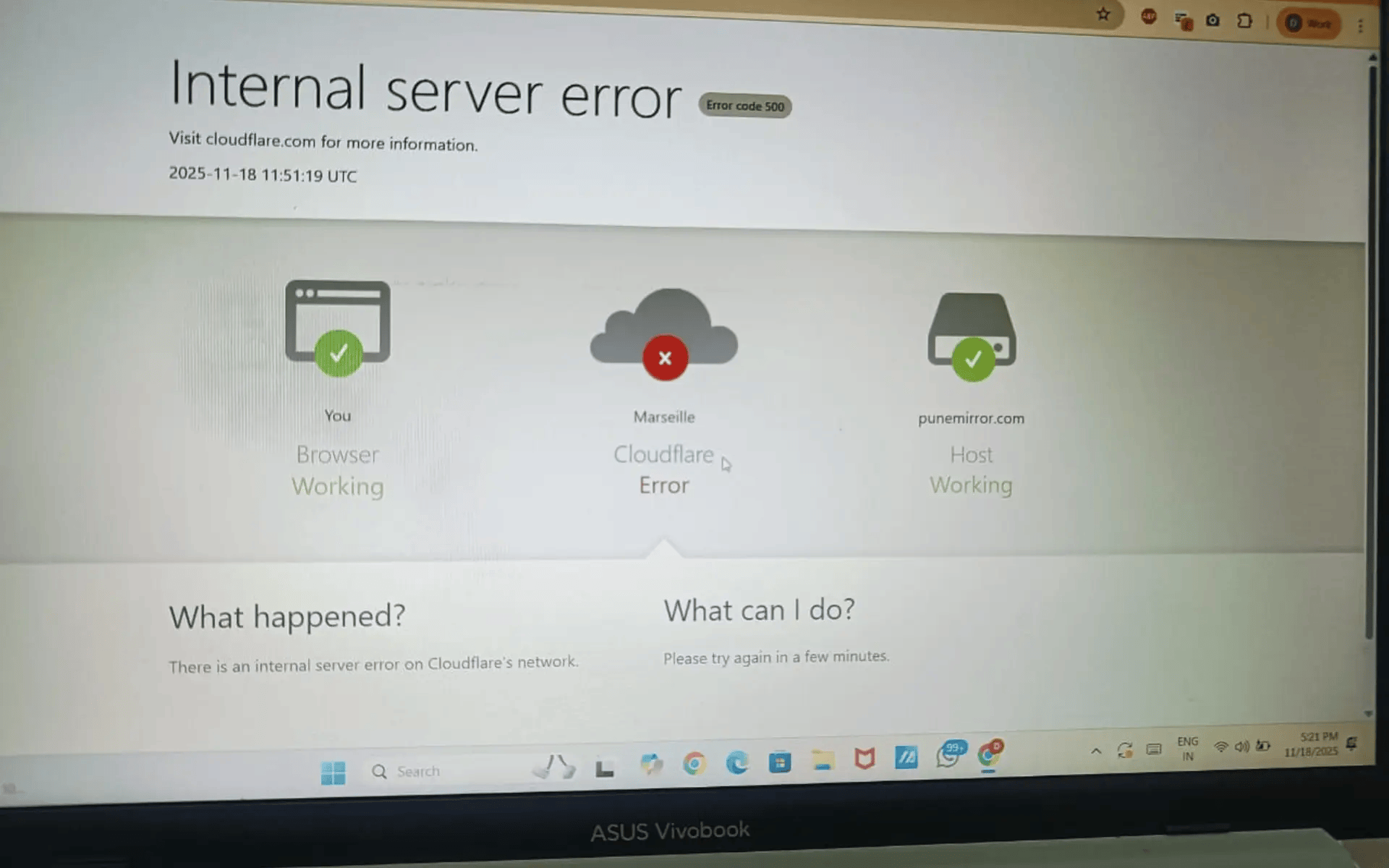On November 18, 2025, a significant portion of the internet experienced widespread disruptions when Cloudflare, one of the world’s most critical internet infrastructure providers, suffered a major outage. The incident left millions of users unable to access popular platforms, including X (formerly Twitter), ChatGPT, Spotify, and countless other websites that rely on Cloudflare’s services.
What Happened?
The outage began around 11:20 UTC (5:20 AM ET) when Cloudflare experienced what they described as unusual traffic patterns. Within minutes, users worldwide started encountering the dreaded HTTP 500 error messages indicating internal server failures. Websites displayed error messages stating “internal server error on Cloudflare’s network” and asked users to try again in a few minutes.
The disruption was so extensive that even Downdetector, the website many turn to for checking service outages, was knocked offline because it too relies on Cloudflare’s infrastructure. The irony wasn’t lost on frustrated users who couldn’t even check if others were experiencing the same problems.
The Scope of the Disruption
The outage affected a staggering array of services across multiple sectors:
Major Platforms Hit:
- Social media platform X experienced widespread access issues
- OpenAI’s ChatGPT and Sora video app went offline
- Anthropic’s Claude chatbot was disrupted
- E-commerce platform Shopify faced downtime
- Job search engine Indeed became inaccessible
- President Trump’s Truth Social platform was affected
- Gaming services, including League of Legends and Valorant, had connectivity issues
Even NJ Transit’s digital services were brought down by the outage, demonstrating how deeply embedded Cloudflare’s services are in everyday infrastructure.
The impact was truly global. Thousands of users across India faced service disruptions, with many unable to access websites that rely on Cloudflare’s internet infrastructure.
The Root Cause
According to a Cloudflare spokesperson, the root cause was an automatically generated configuration file used to manage threat traffic that grew beyond its expected size, which triggered a crash in the software system handling traffic for several services.
More specifically, a change to one of Cloudflare’s database systems’ permissions caused the database to output multiple entries into a feature file used by their Bot Management system, causing that file to double in size. This oversized file was then distributed to all machines across Cloudflare’s network, causing the routing software to fail.
Cloudflare’s Chief Technology Officer, Dane Knecht, was quick to rule out malicious activity. He posted an apology on X, stating “This was not an attack” and acknowledged that “The sites, businesses, and organizations that rely on Cloudflare depend on us being available, and I apologize for the impact that we caused”.
The Recovery Process
At 8:13 AM ET, Cloudflare announced that the issue had been identified and a fix was being implemented. The company worked methodically to restore services:
- First, they restored Cloudflare Access and WARP services
- Dashboard services were brought back online
- Application services were gradually recovered
- By around 9:57 AM ET, Cloudflare had implemented a fix to resolve the outage, though some users continued to experience issues accessing the online dashboard.
The entire incident lasted several hours, with most services recovering within three to four hours of the initial disruption.
The Broader Context
This outage is part of a concerning trend of major internet infrastructure failures. The incident came less than a month after Amazon Web Services suffered a daylong disruption that took down numerous online services, followed by a global outage of Microsoft’s Azure cloud and 365 services.
As one cybersecurity expert noted, “During today’s outage, news sites, payments, public information pages, and community services all froze. That was not because each organisation failed on its own. It was because a single layer they all rely on stopped responding”.
This concentration of internet infrastructure in the hands of a few major providers creates a single point of failure that can disrupt services globally. When Cloudflare, AWS, or similar providers experience issues, the ripple effects are felt across industries and continents.
Market Impact
The outage didn’t go unnoticed by investors. Shares of Cloudflare slid more than 2% following the incident, reflecting concerns about the reliability of critical internet infrastructure.
Cloudflare’s Response
To their credit, Cloudflare was transparent about the incident. A spokesperson stated, “Given the importance of Cloudflare’s services, any outage is unacceptable. We apologize to our customers and the internet in general for letting you down today”.
The company has promised a detailed post-mortem analysis and committed to implementing measures to prevent similar incidents in the future.
Conclusion
The November 18 Cloudflare outage serves as a stark reminder of how interconnected and fragile our digital infrastructure can be. As more businesses and services consolidate their infrastructure needs with a handful of major providers, the potential impact of any single outage grows exponentially.
While Cloudflare’s rapid response and transparency are commendable, the incident raises important questions about internet resilience and the wisdom of concentrating so much digital infrastructure in so few hands. As our lives become increasingly digital, ensuring the reliability and redundancy of these critical services becomes ever more important.
FAQ
What causes Cloudflare outages?
The November 18, 2025, outage was caused by a technical configuration error rather than an external attack. Specifically, an automatically generated configuration file used for bot management exceeded its expected size due to a change in database permissions. This oversized file was distributed across Cloudflare’s global network, causing the traffic routing software to crash. The issue was purely internal and resulted from a system configuration error, rather than malicious activity or a cyberattack.
Is ChatGPT affected by Cloudflare?
Yes, ChatGPT was significantly affected by the November 18 Cloudflare outage. OpenAI’s services, including ChatGPT and the Sora short-form video app, experienced disruptions due to Cloudflare being a third-party service provider for OpenAI. During the outage, users were unable to access ChatGPT for several hours. OpenAI’s status page confirmed the issues were related to problems with their third-party service provider (Cloudflare), and services fully recovered once Cloudflare resolved the underlying infrastructure issues.
How did Cloudflare go down?
Cloudflare went down due to a cascading technical failure. A change in database permissions caused a Bot Management feature file to double in size unexpectedly. This larger-than-normal file was automatically propagated to all machines in Cloudflare’s network worldwide. The routing software on these machines, designed to handle files of a certain size, couldn’t process the oversized file and crashed. This caused widespread 500 errors across the network beginning at 11:20 UTC. The company identified the issue, implemented a fix by reverting the problematic configuration, and gradually restored services over several hours.
Is Cloudflare blocked in India?
No, Cloudflare itself is not blocked in India. The November 18, 2025, outage affected users in India just as it did users globally. Thousands of Indian users experienced disruptions to services like X, ChatGPT, and other Cloudflare-dependent websites during the incident. However, it’s worth noting that occasionally, specific websites using Cloudflare’s services may be blocked by Indian ISPs due to content regulations or government orders targeting those specific sites, not Cloudflare itself. Some Indian ISPs have historically blocked certain Cloudflare IP ranges when those IPs were associated with sites containing content deemed illegal in India, but this is not a blanket block of Cloudflare’s services.






Leave A Comment